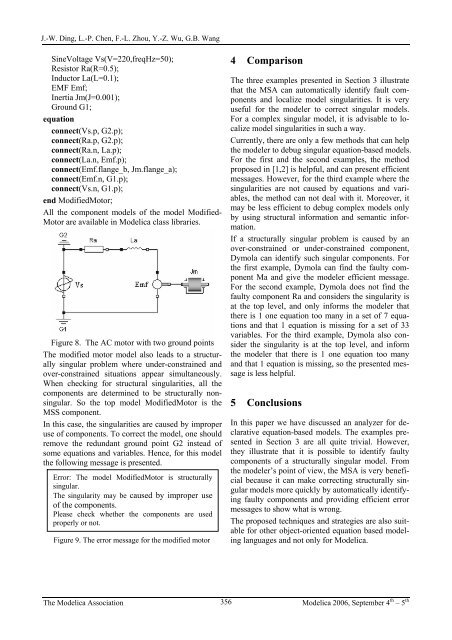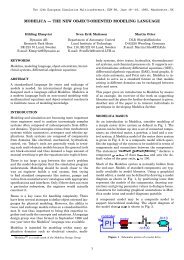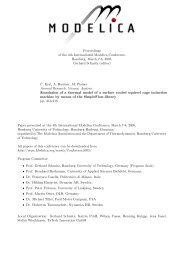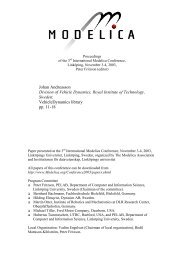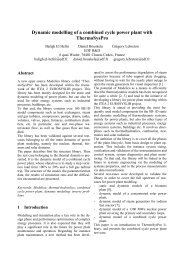Proceedings of the 5th International Modelica Conference Volume 2
Proceedings of the 5th International Modelica Conference Volume 2
Proceedings of the 5th International Modelica Conference Volume 2
You also want an ePaper? Increase the reach of your titles
YUMPU automatically turns print PDFs into web optimized ePapers that Google loves.
J.-W. Ding, L.-P. Chen, F.-L. Zhou, Y.-Z. Wu, G.B. Wang<br />
SineVoltage Vs(V=220,freqHz=50);<br />
Resistor Ra(R=0.5);<br />
Inductor La(L=0.1);<br />
EMF Emf;<br />
Inertia Jm(J=0.001);<br />
Ground G1;<br />
equation<br />
connect(Vs.p, G2.p);<br />
connect(Ra.p, G2.p);<br />
connect(Ra.n, La.p);<br />
connect(La.n, Emf.p);<br />
connect(Emf.flange_b, Jm.flange_a);<br />
connect(Emf.n, G1.p);<br />
connect(Vs.n, G1.p);<br />
end ModifiedMotor;<br />
All <strong>the</strong> component models <strong>of</strong> <strong>the</strong> model Modified-<br />
Motor are available in <strong>Modelica</strong> class libraries.<br />
Figure 8. The AC motor with two ground points<br />
The modified motor model also leads to a structurally<br />
singular problem where under-constrained and<br />
over-constrained situations appear simultaneously.<br />
When checking for structural singularities, all <strong>the</strong><br />
components are determined to be structurally nonsingular.<br />
So <strong>the</strong> top model ModifiedMotor is <strong>the</strong><br />
MSS component.<br />
In this case, <strong>the</strong> singularities are caused by improper<br />
use <strong>of</strong> components. To correct <strong>the</strong> model, one should<br />
remove <strong>the</strong> redundant ground point G2 instead <strong>of</strong><br />
some equations and variables. Hence, for this model<br />
<strong>the</strong> following message is presented.<br />
Error: The model ModifiedMotor is structurally<br />
singular.<br />
The singularity may be caused by improper use<br />
<strong>of</strong> <strong>the</strong> components.<br />
Please check whe<strong>the</strong>r <strong>the</strong> components are used<br />
properly or not.<br />
Figure 9. The error message for <strong>the</strong> modified motor<br />
4 Comparison<br />
The three examples presented in Section 3 illustrate<br />
that <strong>the</strong> MSA can automatically identify fault components<br />
and localize model singularities. It is very<br />
useful for <strong>the</strong> modeler to correct singular models.<br />
For a complex singular model, it is advisable to localize<br />
model singularities in such a way.<br />
Currently, <strong>the</strong>re are only a few methods that can help<br />
<strong>the</strong> modeler to debug singular equation-based models.<br />
For <strong>the</strong> first and <strong>the</strong> second examples, <strong>the</strong> method<br />
proposed in [1,2] is helpful, and can present efficient<br />
messages. However, for <strong>the</strong> third example where <strong>the</strong><br />
singularities are not caused by equations and variables,<br />
<strong>the</strong> method can not deal with it. Moreover, it<br />
may be less efficient to debug complex models only<br />
by using structural information and semantic information.<br />
If a structurally singular problem is caused by an<br />
over-constrained or under-constrained component,<br />
Dymola can identify such singular components. For<br />
<strong>the</strong> first example, Dymola can find <strong>the</strong> faulty component<br />
Ma and give <strong>the</strong> modeler efficient message.<br />
For <strong>the</strong> second example, Dymola does not find <strong>the</strong><br />
faulty component Ra and considers <strong>the</strong> singularity is<br />
at <strong>the</strong> top level, and only informs <strong>the</strong> modeler that<br />
<strong>the</strong>re is 1 one equation too many in a set <strong>of</strong> 7 equations<br />
and that 1 equation is missing for a set <strong>of</strong> 33<br />
variables. For <strong>the</strong> third example, Dymola also consider<br />
<strong>the</strong> singularity is at <strong>the</strong> top level, and inform<br />
<strong>the</strong> modeler that <strong>the</strong>re is 1 one equation too many<br />
and that 1 equation is missing, so <strong>the</strong> presented message<br />
is less helpful.<br />
5 Conclusions<br />
In this paper we have discussed an analyzer for declarative<br />
equation-based models. The examples presented<br />
in Section 3 are all quite trivial. However,<br />
<strong>the</strong>y illustrate that it is possible to identify faulty<br />
components <strong>of</strong> a structurally singular model. From<br />
<strong>the</strong> modeler’s point <strong>of</strong> view, <strong>the</strong> MSA is very beneficial<br />
because it can make correcting structurally singular<br />
models more quickly by automatically identifying<br />
faulty components and providing efficient error<br />
messages to show what is wrong.<br />
The proposed techniques and strategies are also suitable<br />
for o<strong>the</strong>r object-oriented equation based modeling<br />
languages and not only for <strong>Modelica</strong>.<br />
The <strong>Modelica</strong> Association <strong>Modelica</strong> 2006, September 4 th – 5 th<br />
356


